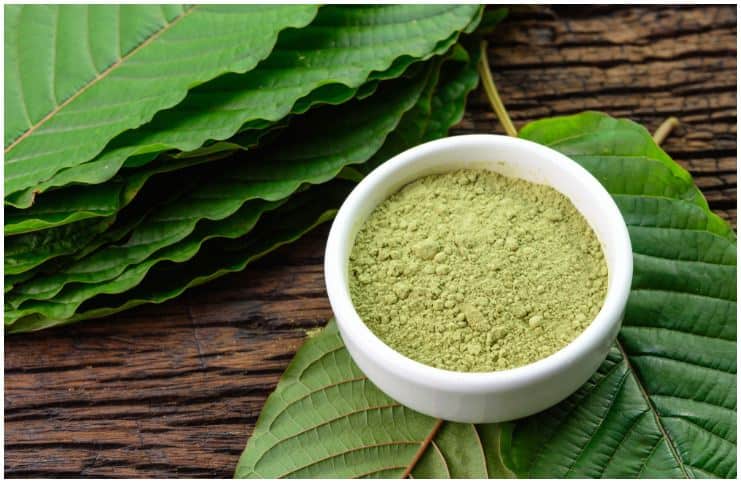Kratom (botanical name – Mitragyna speciosa) is a tropical tree from the Rubiaceae family that can grow up to 25 m tall.
M. speciosa tree, also known as Ketum or Thom, is native to Indonesia, Thailand, Myanmar, Malaysia, and Papua New Guinea and has some opiate and stimulant-like properties. However, while it has many of the effects of opiates, the two are not the same thing.
The tree leaves have been used for many years in Asia for medicinal purposes and are very bitter, that’s why many people prefer to take it in a liquid tea form with a sweetener.
Chemical composition
There are at least 40 active substances in this plant, such as – pausinystalia johimbe, 7-hydroxymitragynine (it has been shown to be 13 times more potent than morphine as an antinociceptive agent in studies), mitragynine (an indole-based opioid and the most abundant active alkaloid in the plant), rhynchophylline, paynantheine, corynanthidine, speciocilatine, raubasine, speciogynine. Also, different varieties of the tree may have more potent opioid effects.
Health Benefits of Kratom
Opiate withdrawal
This plant is used as an alternative treatment for pain and opiate addiction and from opioid medicine withdrawals.
Opiate withdrawal can be very uncomfortable and numerous individuals continue using these drugs to avoid unpleasant symptoms.
Boosts immunity
It is known in traditional medicine as a method to fight immune system disorders due to its antiviral substances. It contains 20 times the amount of antioxidants found in green tea.
Diarrhea home remedy
In Thai folk medicine, the leaves were boiled and served as a tea treatment for diarrhea.
Helps you sleep
Dried leaves of M. speciosa can cause a sedative effect, with feelings of euphoria and calmness for up to six hours.
Boosts energy levels
It has similar effects to caffeine by stimulating the brain and muscles which ultimately will make you have more energy to do other tasks.
Chronic pain relief
It helps alleviate chronic pain within 5 to 10 minutes after consumption. The effects can last for a few hours.
Natural remedy for depression
More than 17 million people in the US have at least one major depressive episode every year.
Kratom has been shown to reduce the effects of anxiety and depression, possibly because it contains many psychoactive compounds.
How To Use
You can intake it in a powdered form, a pure leaf form, a liquid form. The majority of patients will only need to use 5 to 10 grams.
Bans
This plant is banned in Latvia, New Zealand, Denmark, Australia, Lithuania, Romania, Poland, and Sweden. Also, it is banned by ASEAN member states and cannot be included in health supplements and traditional medicines.
According to act 2486 from August 3, 1943, it is illegal planting the tree in Thailand. However, the Thai government considered legalizing for opiate withdrawal.
In addition, Arkansas, Alabama, Tennessee, Indiana, Vermont, and Wisconsin and the United States Army had made this plant illegal for use.
Side Effects of Kratom
There have not been many studies on the long-term effects of consuming this plant. However, it was observed that the main problems are linked with the consumption of high doses and used in conjunction with other drugs. Long term users become thin, their skin darkens, which gives an appearance similar to a hepatic face.
Side effects include:
- vomiting, nausea, constipation, and loss of appetite;
- frequent micturition;
- anorexia and severe weight loss;
- agitation, insomnia and sleep disorders;
- addiction, seizure, and psychosis;
- high heart rate and blood pressure, and liver toxicity;
- blushing and contracted pupils;
- itching;
- dryness in the mouth and sweating;
- dangerous interactions with other medications or drugs due to some chemicals found in this plant which interfere with drug-metabolizing enzymes in the liver.
Pregnant and nursing women and children are advised to refrain from using this plant.
Withdrawal Symptoms
Withdrawal is the set of distressing physical symptoms that appear when you stop intaking an addictive compound. Withdrawal symptoms include aggression, irritability, hostility, inability to work, anxiety, wet nose, headaches, or jerky movement of the limbs.
Overdose
The cause of a drug overdose is either by intentional misuse or by accidental overuse. Respiratory depression is an important risk with this type of substances, particularly for those who have activity at the mu-opioid receptor.
Usual symptoms of an overdose include -pupils will contract and appear small, the face is very pale, loss of consciousness, vomiting, or very slow breathing.
An overdose with M. speciosa is managed similar to the overdose of opioids and involves breathing and providing oxygen treatment with naloxone.
Note
Between 2014 and 2016, 15 deaths in the U.S. were related to the consumption of this natural remedy. In Sweden. between 2010 and 2011 nine cases of deaths were reported relating to the use of M. speciosa combined with O-Desmethyltramadol (the main active metabolite of tramadol).
However, this is a pretty low number compared to drug overdose total deaths in the United States in 2014 that is 47,055.
References https://www.ncbi.nlm.nih.gov/pubmed/25081682 https://www.ncbi.nlm.nih.gov/pmc/articles/PMC3670991/ https://www.wisconsinmedicalsociety.org/_WMS/publications/wmj/pdf/115/1/49.pdf



